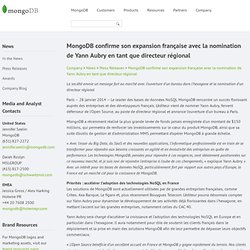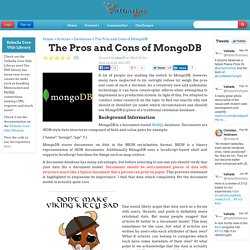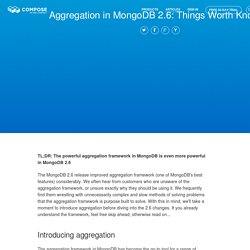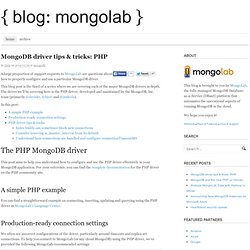

MongoDB - Qui l'utilise ? La société envoie un message fort au marché avec l’ouverture d’un bureau dans l’hexagone et la nomination d’un directeur régional Paris – 28 janvier 2014 – Le leader des bases de données NoSQL MongoDB rencontre un succès florissant auprès des entreprises et des développeurs français.

L’éditeur vient de nommer Yann Aubry, fervent défenseur de l’Open Source, au poste de directeur régional et annonce l’ouverture d’un bureau à Paris. MongoDB a récemment réalisé la plus grande levée de fonds jamais enregistrée d’un montant de $150 millions, qui permettra de renforcer les investissements sur le cœur du produit MongoDB, ainsi que sa suite d’outils de gestion et d’administration MMS permettant d’opérer MongoDB à grande échelle. « Avec l’essor du Big Data, du SaaS et des nouvelles applications, l’informatique professionnelle est en train de se transformer pour répondre aux besoins croissants en agilité et en évolutivité des entreprises en quête de performance. Avantages et inconvenients. A lot of people are making the switch to MongoDB, however many have neglected to (or outright refuse to) weigh the pros and cons of such a decision.

As a relatively new and unfamiliar technology, it can have catastrophic effects when attempting to implement in a production system. In light of this, I've attepted to conduct some research on the topic to find out exactly why one should or shouldn't (or under which circumstances one should) use MongoDB in place of a traditional relational database. Background Information MongoDB is a document-based NoSQL database. Documents are JSON-style data structures composed of field-and-value pairs for example: MongoDB stores documents on disk in the BSON serialization format. A document database has many advantages, but before selecting to use one you should verify that your data fits a document model.
One would likely argue that data such as a forum with users, threads, and posts is definitely more relational data. Advantages Disadvantages. FAQ — MongoDB Manual 2.6.1. Aggregation Concepts — MongoDB Manual 2.6.1. MongoDB provides the three approaches to aggregation, each with its own strengths and purposes for a given situation.

This section describes these approaches and also describes behaviors and limitations specific to each approach. See also the chart that compares the approaches. MongoDB - Wiki. Un article de Wikipédia, l'encyclopédie libre.

MongoDB (de l'anglais humongous qui peut être traduit par « énorme ») est un système de gestion de base de données orientée documents, répartissable sur un nombre quelconque d'ordinateurs, efficace pour les requêtes simples, et ne nécessitant pas de schéma prédéfini des données. MongoDB Blog. By Sunil Sadasivin, CTO at Buffer Buffer, powered by experiments and metrics At Buffer, every product decision we make is driven by quantitative metrics.

We have always sought to be lean in our decision making, and one of the core tenants of being lean is launching experimental features early and measuring their impact. Buffer is a social media tool to help you schedule and space out your posts on social media networks like Twitter, Facebook, Google+ and Linkedin. We started in late 2010 and thanks to a keen focus on analytical data, we have now grown to over 1.5 million users and 155k unique active users per month. When I started at Buffer in September 2012 we were using a mixture of Google Analytics, Kissmetrics and an internal tool to track our app usage and analytics.
Aggregation in MongoDB 2.6: Things Worth Knowing. TL;DR: The powerful aggregation framework in MongoDB is even more powerful in MongoDB 2.6 The MongoDB 2.6 release improved aggregation framework (one of MongoDB's best features) considerably.

We often hear from customers who are unaware of the aggregation framework, or unsure exactly why they should be using it. We frequently find them wrestling with unnecessarily complex and slow methods of solving problems that the aggregation framework is purpose built to solve. With this in mind, we'll take a moment to introduce aggregation before diving into the 2.6 changes. If you already understand the framework, feel free skip ahead; otherwise read on... Introducing aggregation The aggregation framework in MongoDB has become the go-to tool for a range of problems which would traditionally have been solved with the map-reduce engine. Step by step We prefer to show rather than tell, so lets look at a worked example. (The program uses the Faker.js library to mock up records. PHP MongoDB driver examples & tips.
A large proportion of support requests to MongoLab are questions about how to properly configure and use a particular MongoDB driver.

This blog post is the third of a series where we are covering each of the major MongoDB drivers in depth. The driver we’ll be covering here is the PHP driver, developed and maintained by the MongoDB, Inc. team (primarily @derickr, @bjori and @jmikola). In this post: This post aims to help you understand how to configure and use the PHP driver effectively in your MongoDB application. For your reference, you can find the complete documentation for the PHP driver on the PHP community site. A simple PHP example You can find a straightforward example on connecting, inserting, updating and querying using the PHP driver in MongoLab’s Language Center. Production-ready connection settings We often see incorrect configurations of the driver, particularly around timeouts and replica set connections. PHP driver tips & tricks Index builds can sometimes block new connections. NoSQL Databases and Polyglot Persistence: A Curated Guide.